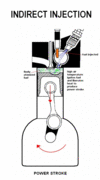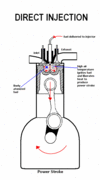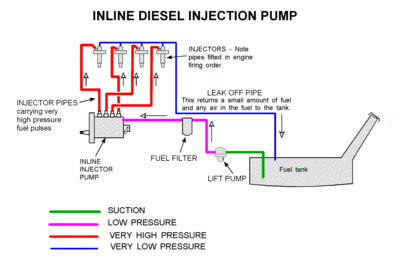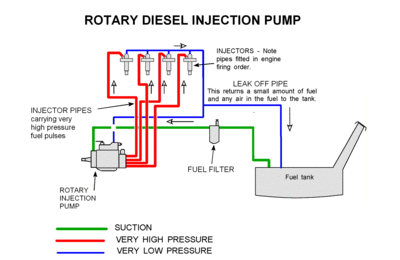Difference between revisions of "Vegetable oil as fuel"
m |
m |
||
| (11 intermediate revisions by the same user not shown) | |||
| Line 1: | Line 1: | ||
| − | |||
| − | |||
<metadesc>using vegetable oil as fuel</metadesc> | <metadesc>using vegetable oil as fuel</metadesc> | ||
| − | |||
| − | |||
=Introduction to Vegetable Oil as Fuel= | =Introduction to Vegetable Oil as Fuel= | ||
| Line 9: | Line 5: | ||
It is possible for any diesel engine to run with vegetable oil as a replacement to diesel fuel but the ancillary fuel system components and the design of the engine itself may make long term use of vegetable oil as a fuel impractical or impossible. | It is possible for any diesel engine to run with vegetable oil as a replacement to diesel fuel but the ancillary fuel system components and the design of the engine itself may make long term use of vegetable oil as a fuel impractical or impossible. | ||
| − | Before you embark on using vegetable oil | + | Before you embark on using vegetable oil instead of diesel there are many factors to be considered and they fall loosely into three categories, the suitability of the engine, the suitability of the fuel system and the suitability of the vegetable oil. |
| + | |||
| + | __TOC__ | ||
=The Suitability of the Engine= | =The Suitability of the Engine= | ||
| − | In order to discover whether it is possible to use vegetable oil as fuel in your engine, your first step will be to establish exactly which engine and injection system you have. Armed with this information and | + | In order to discover whether it is possible to use vegetable oil as fuel in your engine, your first step will be to establish exactly which engine and injection system you have. Armed with this information and supported by sufficient research and possibly making reference to databases of users who have successfully (and sometimes unsuccessfully) run their engines on vegetable oil, you will be able to make an informed choice as to whether you believe your engine is suitable for long term use of vegetable oil. |
| + | |||
| + | [[File:IDI.gif|100px|thumb|left|(source:unknown)]] | ||
| + | ==Indirect Injection Engines== | ||
| + | |||
| + | Indirect injection engines (those with glow plugs and pre-swirl chambers) are the most suitable engines for running vegetable oil. Due to their design, there is more chance of complete combustion due to better mixing with air, higher temperatures in the swirl chamber, and unlike direct injection engines, the fuel is never sprayed directly into a cold cylinder. | ||
| + | |||
| + | |||
| + | |||
| + | |||
| + | |||
| + | |||
| − | |||
| − | |||
| + | [[File:DI.gif|100px|thumb|left|(source:unknown)]] | ||
==Direct Injection Engines== | ==Direct Injection Engines== | ||
| − | The primary problem with direct injection engines when using vegetable oil | + | The primary problem with direct injection engines when using vegetable oil is that until the engine has reached operating temperature, the more viscous and therefore poorly atomised fuel is injected into a cold cylinder resulting in the possibility of unburnt fuel hitting the cylinder walls and being swept up by the piston rings. Eventually this unburnt fuel forms a hard rubbery mass (similar to what can be found on the bottom of a well used frying pan) which gums the piston rings into their grooves and prevents them following the contours of the cylinder, resulting in loss of compression. |
If vegetable oil is to be used in a direct injection engine, some means of lowering its viscosity to aid atomisation and encourage a complete burn must be used. Typically this could be blending with a thinning agent or heating the vegetable oil prior to it's injection into the cylinder. | If vegetable oil is to be used in a direct injection engine, some means of lowering its viscosity to aid atomisation and encourage a complete burn must be used. Typically this could be blending with a thinning agent or heating the vegetable oil prior to it's injection into the cylinder. | ||
| + | |||
| + | The effects of ring gumming can be successfully overcome to some degree using water injection on some engines. | ||
| + | |||
| + | |||
| + | |||
| + | |||
| + | |||
| Line 36: | Line 51: | ||
| − | |||
| − | Older diesel engines are often fitted with inline injection | + | [[File:inline IP.gif|400px|thumb|left|(source: max.print)]] |
| + | ==Inline Injection Pumps== | ||
| + | |||
| + | Older diesel engines are often fitted with an inline injection pump. They are one of the first injection pump designs to be created and are still a popular choice for many modern lorries, construction plant, static engines and agricultural vehicles. Their robustness and simplicity often makes them very tolerant of pumping vegetable oil. | ||
| + | |||
| + | |||
| + | |||
| + | |||
| + | |||
| + | |||
| + | |||
| + | |||
| + | |||
| + | |||
| + | |||
| + | |||
| + | |||
| + | [[File:Rotary_IP.gif|400px|thumb|left|(source: max.print)]] | ||
==Rotary Injection Pumps== | ==Rotary Injection Pumps== | ||
| − | Most rotary injection pumps use the fuel that they are pumping to also lubricate the moving parts within the pump. It has been discovered that due to the design and finer tolerances within Lucas/CAV injection pumps, at lower operating temperatures they are unable to feed the more viscous vegetable oil to the areas that need lubrication and as a result there have been many recorded cases of the rotor seizing within the pump body causing failure of the shaft. This problem has been successfully overcome in many cases using a twin tank system where the engine is brought up to operating temperature using diesel from one fuel tank and then once up to operating temperature, a switching system is used to change to a separate fuel tank containing vegetable oil. It is important to switch back to diesel towards the end of each journey in order to purge the fuel system of vegetable oil thus enabling the next start up to be on diesel. | + | Most rotary injection pumps use the fuel that they are pumping to also lubricate the moving parts within the pump. It has been discovered that due to the design and finer tolerances within Lucas/CAV injection pumps, at lower operating temperatures they are unable to feed the more viscous vegetable oil to the areas that need lubrication and as a result there have been many recorded cases of the rotor seizing within the pump body causing failure of the shaft. |
| + | |||
| + | This problem has been successfully overcome in many cases using a twin tank system where the engine is brought up to operating temperature using diesel from one fuel tank and then once up to operating temperature, a switching system is used to change to a separate fuel tank containing vegetable oil. It is important to switch back to diesel towards the end of each journey in order to purge the fuel system of vegetable oil thus enabling the next start up to be on diesel. | ||
| + | |||
| + | Most Bosch rotary pumps and the 'made under license' Japanese versions are more tolerant to viscous vegetable oil and there are many reports of engines equipped with these pumps having successfully covered tens of thousands of problem free miles. | ||
| + | |||
| + | |||
| + | |||
| − | |||
| + | ==Unit Injectors== | ||
| − | + | Unit Injectors work by combining an individual high pressure pump within each injector, the system eliminates the need for high pressure fuel pipes and allows for much higher injection pressure to occur. On modern engines such as those using the VAG group's PD (Pumpe Düse) injection system and Landrover's TD5, they are then electronically controlled for highly accurate injection timing and quantity control. | |
| − | + | The drawback of this accuracy for the vegetable oil user is that the fuel system is very sensitive to changes in fuel and the use of vegetable oil can result in expensive component damage. | |
| + | ==Common Rail== | ||
| − | + | The common rail injection system is used by most modern diesel car engines. It features a high pressure fuel pump which supplies constant high pressure fuel to all the injectors which are in turn controlled electronically for timing and fuel quantity by the ECU. This system offers great control and accuracy but has the similar drawbacks to the vegetable oil user as unit injectors. | |
| − | + | Some common rail equipped engines have however been successfully run using vegetable oil by treating them in the same way as Lucas/CAV rotary pumps and bringing them up to operating temperature on diesel before switching to heated vegetable oil from a separate fuel tank. | |
=The Suitability of Vegetable Oil= | =The Suitability of Vegetable Oil= | ||
| − | '''Vegetable oil is not biodiesel.''' Biodiesel is vegetable oil that has been chemically altered | + | '''Vegetable oil is not biodiesel.''' Biodiesel is vegetable oil that has been chemically altered during a chemical reaction called transesterification. |
Vegetable oil to be used as fuel can be either new and bought from the cash and carry or supermarket (this is commonly called Straight Vegetable Oil and is abbreviated to SVO) or oil that has been previously used for cooking (this is commonly called Waste Vegetable Oil and is abbreviated to WVO or Used Cooking Oil which is abbreviated to UCO) | Vegetable oil to be used as fuel can be either new and bought from the cash and carry or supermarket (this is commonly called Straight Vegetable Oil and is abbreviated to SVO) or oil that has been previously used for cooking (this is commonly called Waste Vegetable Oil and is abbreviated to WVO or Used Cooking Oil which is abbreviated to UCO) | ||
| Line 70: | Line 109: | ||
==Viscosity== | ==Viscosity== | ||
| − | Vegetable oil is much more viscous that diesel and will put a greater strain on the fuel system components. | + | Vegetable oil is much more viscous that diesel and will put a greater strain on the fuel system components. This also hinders atomisation which makes it harder to obtain a complete burn, especially in a cold engine. You can lower the viscosity of your oil by either heating it before it enters the main fuel system components or by blending it with a thinning agent such as petrol before you put it in your fuel tank. |
==Contaminates== | ==Contaminates== | ||
Latest revision as of 15:55, 25 January 2012
Introduction to Vegetable Oil as Fuel
It is possible for any diesel engine to run with vegetable oil as a replacement to diesel fuel but the ancillary fuel system components and the design of the engine itself may make long term use of vegetable oil as a fuel impractical or impossible.
Before you embark on using vegetable oil instead of diesel there are many factors to be considered and they fall loosely into three categories, the suitability of the engine, the suitability of the fuel system and the suitability of the vegetable oil.
Contents
The Suitability of the Engine
In order to discover whether it is possible to use vegetable oil as fuel in your engine, your first step will be to establish exactly which engine and injection system you have. Armed with this information and supported by sufficient research and possibly making reference to databases of users who have successfully (and sometimes unsuccessfully) run their engines on vegetable oil, you will be able to make an informed choice as to whether you believe your engine is suitable for long term use of vegetable oil.
Indirect Injection Engines
Indirect injection engines (those with glow plugs and pre-swirl chambers) are the most suitable engines for running vegetable oil. Due to their design, there is more chance of complete combustion due to better mixing with air, higher temperatures in the swirl chamber, and unlike direct injection engines, the fuel is never sprayed directly into a cold cylinder.
Direct Injection Engines
The primary problem with direct injection engines when using vegetable oil is that until the engine has reached operating temperature, the more viscous and therefore poorly atomised fuel is injected into a cold cylinder resulting in the possibility of unburnt fuel hitting the cylinder walls and being swept up by the piston rings. Eventually this unburnt fuel forms a hard rubbery mass (similar to what can be found on the bottom of a well used frying pan) which gums the piston rings into their grooves and prevents them following the contours of the cylinder, resulting in loss of compression.
If vegetable oil is to be used in a direct injection engine, some means of lowering its viscosity to aid atomisation and encourage a complete burn must be used. Typically this could be blending with a thinning agent or heating the vegetable oil prior to it's injection into the cylinder.
The effects of ring gumming can be successfully overcome to some degree using water injection on some engines.
The Suitability of the Fuel System
CAUTION – Incorrect choices here could result in major fuel system damage.
There are several systems of injecting the fuel into a diesel engine. The most common injection systems are inline pump, rotary pump, unit injectors and common rail. Some of these systems are more suited to vegetable oil than others and some are so sensitive and expensive to repair that the risks involved are generally prohibitive.
Inline Injection Pumps
Older diesel engines are often fitted with an inline injection pump. They are one of the first injection pump designs to be created and are still a popular choice for many modern lorries, construction plant, static engines and agricultural vehicles. Their robustness and simplicity often makes them very tolerant of pumping vegetable oil.
Rotary Injection Pumps
Most rotary injection pumps use the fuel that they are pumping to also lubricate the moving parts within the pump. It has been discovered that due to the design and finer tolerances within Lucas/CAV injection pumps, at lower operating temperatures they are unable to feed the more viscous vegetable oil to the areas that need lubrication and as a result there have been many recorded cases of the rotor seizing within the pump body causing failure of the shaft.
This problem has been successfully overcome in many cases using a twin tank system where the engine is brought up to operating temperature using diesel from one fuel tank and then once up to operating temperature, a switching system is used to change to a separate fuel tank containing vegetable oil. It is important to switch back to diesel towards the end of each journey in order to purge the fuel system of vegetable oil thus enabling the next start up to be on diesel.
Most Bosch rotary pumps and the 'made under license' Japanese versions are more tolerant to viscous vegetable oil and there are many reports of engines equipped with these pumps having successfully covered tens of thousands of problem free miles.
Unit Injectors
Unit Injectors work by combining an individual high pressure pump within each injector, the system eliminates the need for high pressure fuel pipes and allows for much higher injection pressure to occur. On modern engines such as those using the VAG group's PD (Pumpe Düse) injection system and Landrover's TD5, they are then electronically controlled for highly accurate injection timing and quantity control.
The drawback of this accuracy for the vegetable oil user is that the fuel system is very sensitive to changes in fuel and the use of vegetable oil can result in expensive component damage.
Common Rail
The common rail injection system is used by most modern diesel car engines. It features a high pressure fuel pump which supplies constant high pressure fuel to all the injectors which are in turn controlled electronically for timing and fuel quantity by the ECU. This system offers great control and accuracy but has the similar drawbacks to the vegetable oil user as unit injectors.
Some common rail equipped engines have however been successfully run using vegetable oil by treating them in the same way as Lucas/CAV rotary pumps and bringing them up to operating temperature on diesel before switching to heated vegetable oil from a separate fuel tank.
The Suitability of Vegetable Oil
Vegetable oil is not biodiesel. Biodiesel is vegetable oil that has been chemically altered during a chemical reaction called transesterification.
Vegetable oil to be used as fuel can be either new and bought from the cash and carry or supermarket (this is commonly called Straight Vegetable Oil and is abbreviated to SVO) or oil that has been previously used for cooking (this is commonly called Waste Vegetable Oil and is abbreviated to WVO or Used Cooking Oil which is abbreviated to UCO)
SVO is probably the easiest biofuel to use in a suitable diesel engine but is also the most expensive. WVO is a much cheaper and more environmentally friendly alternative as once it has been used for cooking, it becomes a waste product. The downside to this is that it requires processing before use as a fuel.
There are a number of problems associated with using vegetable oil as a fuel in a suitable engine but most of these issues can generally be overcome to an acceptable degree by exercising care when processing your fuel. The main issues with using vegetable oil as fuel are:
Viscosity
Vegetable oil is much more viscous that diesel and will put a greater strain on the fuel system components. This also hinders atomisation which makes it harder to obtain a complete burn, especially in a cold engine. You can lower the viscosity of your oil by either heating it before it enters the main fuel system components or by blending it with a thinning agent such as petrol before you put it in your fuel tank.
Contaminates
Used oil will contain food particles and fats which can block the various filters in your fuel system. Filtering well settled, liquid oil to a level below that of your main fuel filter (generally 10 micron) should be done at a similar ambient temperature to when you are intending to use your fuel and should remove food particles and fats.
Water
Used oil may contain suspended water which will cause long term damage to the fuel system and enable the free fatty acids within the oil to become corrosive. Dewatering can be achieved using either the heat and settle method or by boiling the water off.
Energy Value
Vegetable oils typically contain less energy than diesel so a slight reduction in power and/or fuel economy is common. If this proves to be a problem, some people have had success using products designed to boost the cetane value of your fuel.



